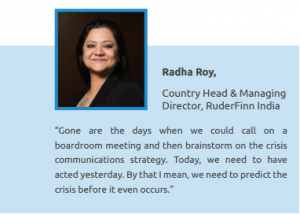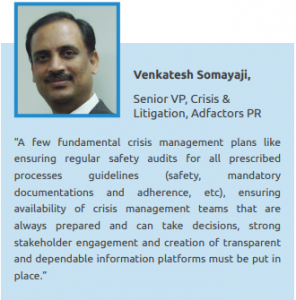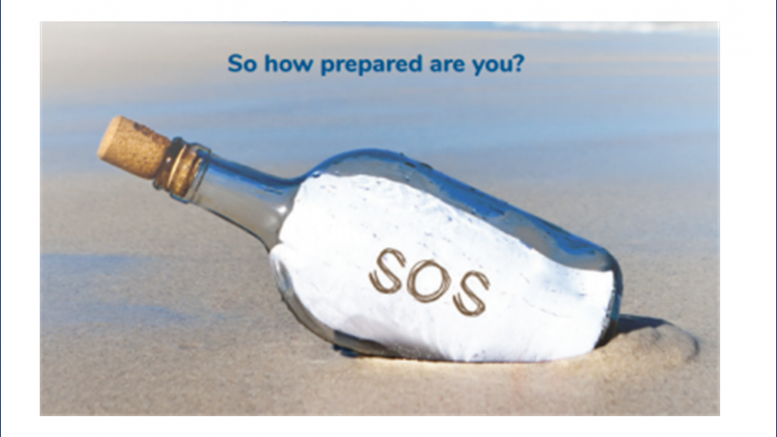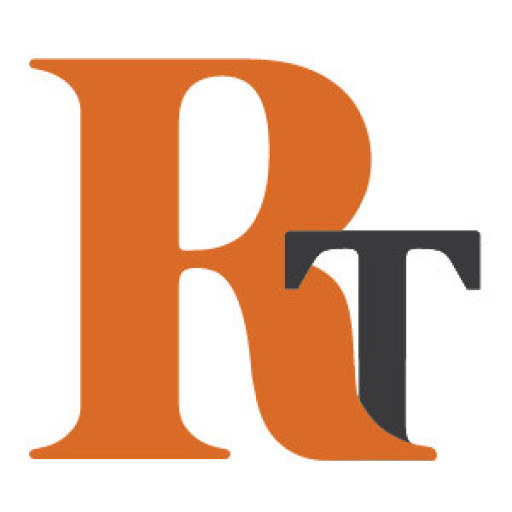In Today’s highly volatile communications environment, anything can be a crisis flashpoint – a single event, a rumor, wrong use of a word… and, a story spirals out of control.
A crisis could hit an organisation any time. Once that happens, there is little time to think, and lesser time to plan. The key to effective crisis communication management is to be prepared before a crisis occurs.
With corporate crises common today, the corporate communicator’s role has become more difficult and demanding – stemming the tide of rumors, mediating among leading corporate decision-makers and delivering clear, concise messages to internal and external audiences.
Regardless of the circumstances, every crisis has the potential to impact a company’s reputation. Companies must have a clear understanding of their audience – employees, customers or a community and then, tailor a crisis management plan.

Mastering chaos
In today’s highly volatile communications environment, anything can be a crisis flashpoint. American business
magnate and philanthropist Warren Buffett, had said, “It can take 20 years to build a reputation and only five minutes to ruin it.” Currently, it may take even less time. The public’s seemingly insatiable appetite for information and demand for accountability, transparency often ignite it out of control. This reality has fundamentally changed how communicators must plan and respond to crises. At the root of this change is a mindset shift from prioritising rapid response to one that demands constant vigilance and preparedness, where the chaos is not just contained and controlled, but mastered.
To master the moments that define crisis communications today, PR professionals must develop a strategy to match.
Coming to terms with chaos or crisis
Few circumstances test a company’s reputation or competency as severely as a crisis. The concept of crisis management has become a specialised activity in the domains of communications and public relations. Whether
the impact is immediate or sustained over time, a crisis affects stakeholders within and outside. Customers cancel
orders. Employees raise questions. CEOs face questions. Shareholders get restless. Competitors sense opportunity.
Governments and regulators come knocking. Interest groups swing into action. Lawyers are not far behind.
Being constantly exposed to political and corporate wrongdoings, there is a demand that corporations become
transparent in their operational practices, financial reporting and social responsibility. The best practice is to engage
your public, your community, your employees and your business partners on each of these three fundamental areas. Companies must explain to their publics how they are doing socially, as a corporate citizen; financially, with their
annual reports; and environmentally. Are they promoting the environment? Are they a good neighbour?
Challenges faced today
Reputation has always been vital to business, but, the exponential growth of digital communications has made it
more vulnerable than ever. The main challenge today is social media and the immediacy of information flow that is realtime. In this ever-changing digitally-advanced world, crisis now takes only a few hours or sometimes even a few minutes to spread; and this is why we need to act fast.
 This in turn can be very challenging, if the right set of tools/trigger points are not embedded in the system and can cause chaos and confusion in communications. In many cases, some clients don’t invest in Online Reputation Management (ORM) and, therefore, do not have the intelligence to react instantly. The other challenge is preparedness as in most cases clients wake up to this need only after a crisis hits. “The challenges faced today are generally the same as have always been faced with the obvious exception of a data breach. Data breaches are now so common that it’s hard to keep up and in any given week there are reports of attacks across all sectors and geographies”, says Chetan Mahajan, President & CEO of Hill+Knowlton Strategies, India.
This in turn can be very challenging, if the right set of tools/trigger points are not embedded in the system and can cause chaos and confusion in communications. In many cases, some clients don’t invest in Online Reputation Management (ORM) and, therefore, do not have the intelligence to react instantly. The other challenge is preparedness as in most cases clients wake up to this need only after a crisis hits. “The challenges faced today are generally the same as have always been faced with the obvious exception of a data breach. Data breaches are now so common that it’s hard to keep up and in any given week there are reports of attacks across all sectors and geographies”, says Chetan Mahajan, President & CEO of Hill+Knowlton Strategies, India.
 The vulnerability today however, is not limited to obvious catastrophes such as a plant explosion or product recall;
The vulnerability today however, is not limited to obvious catastrophes such as a plant explosion or product recall;
rather, social media makes a crisis out of an innocent photo taken by an employee, a careless tweet from an executive, or a falsehood posted on Facebook by someone with an axe to grind or five minutes to kill. More importantly with the emergence of video and growth of language media whatever happens is amplified almost instantly. The challenge is on containing the same with a timely response. “Swift action, transparency, putting yourself out there to be available 24X7 and sometimes taking a stance are critical aspects of dealing with crisis,” observes Valerie Pinto, CEO, Weber Shandwick, India. “Facing crisis in today’s scenario has become extremely difficult due to many factors like: dealing with speed of information, heightened activism and credibility deficit”,
explains Venkatesh Somayaji, Senior VP, Crisis & Litigation, Adfactors PR.
Planning for crisis: minimising chaos
 A corporation must be meticulous about its crisis management plans, and a large portion of the corporate communicator’s time is focused on what to do in times of crisis. A tested crisis communications plan is instrumental in minimising chaos. Communication policies and procedures should be developed as part of the planning phase, not on the verge of, during, or after a disaster.
A corporation must be meticulous about its crisis management plans, and a large portion of the corporate communicator’s time is focused on what to do in times of crisis. A tested crisis communications plan is instrumental in minimising chaos. Communication policies and procedures should be developed as part of the planning phase, not on the verge of, during, or after a disaster.
Response communications must be timely, transparent, and dynamic in order to defuse incident escalations and potential rumors. Unfortunately, during the height of a crisis, the bleak reality often alters the storyline, promoting misinformation.
It is important to never lose sight of the fact that your company will be judged not just for the crisis, but for your company’s handling of it. Fundamentally, any crisis response plan should involve a cross-functional team that represents all the organisational functions. While it is difficult to predict the precise nature of a crisis, holding statements, stakeholder
mapping, social media responses and spokespeople training can all be prepared in advance. The key is ensuring your crisis response plan can be activated at a moment’s notice and that roles and responsibilities are clear – simulation exercises are essential to put this to the test.
It is best to believe that despite any amount of planning, a crisis situation will test the mettle of the organisation, else it would not qualify as a crisis in the first place!
 At GolinOpinion, they have a clear process defined to tackle crisis issues effectively. Plans are developed to allow the organisation to triage situations, make decisions and take quick action. They are direct enough to serve as a strong guide while still being flexible enough to allow room for improvisation that is often needed in a crisis, explains Ameer Ismail. It is critical to train and organise teams to be prepared in the hour of a crisis. For that, “we custom-build trainings and simulations to test teams, stress test crisis plans and prepare client teams to handle just about anything that may come their way,” adds Chetan Mahajan. The trainings are comprehensive and participants learn and practice skills in handling traditional media relations, social media response, operational issues, internal communications and third-party stakeholder communications.
At GolinOpinion, they have a clear process defined to tackle crisis issues effectively. Plans are developed to allow the organisation to triage situations, make decisions and take quick action. They are direct enough to serve as a strong guide while still being flexible enough to allow room for improvisation that is often needed in a crisis, explains Ameer Ismail. It is critical to train and organise teams to be prepared in the hour of a crisis. For that, “we custom-build trainings and simulations to test teams, stress test crisis plans and prepare client teams to handle just about anything that may come their way,” adds Chetan Mahajan. The trainings are comprehensive and participants learn and practice skills in handling traditional media relations, social media response, operational issues, internal communications and third-party stakeholder communications.
 It is vital that employees of an organisation are up to speed on how to use and manage social media effectively in a crisis. Those who lead social media within an organisation may also face situations where they need to manage sudden, largescale negative stories or major incidents. For this purpose, to predict and manage crisis most effectively, Radha Roy informs they have a set of three tools and trainings at RuderFinn, Asia.
It is vital that employees of an organisation are up to speed on how to use and manage social media effectively in a crisis. Those who lead social media within an organisation may also face situations where they need to manage sudden, largescale negative stories or major incidents. For this purpose, to predict and manage crisis most effectively, Radha Roy informs they have a set of three tools and trainings at RuderFinn, Asia.
1) Sonar, which is their training platform that allows teams to experience the dynamic environment of a fast-developing social media issue or crisis in real-time.
2) RiskSTAT, an advanced marketing tool that delivers predictive analytics, influencer mapping that enables you to
be armed and ready.
3) Beacon (Analytics suite), a listening tool that finds ways to turn massive amounts of data into relevant insights.
FireBell is Weber Shandwick’s interactive proprietary training tool that has been recognised the world over as one of the most advanced tools used for preparing clients to deal with crisis. This tool allows companies to understand the issues and crisis environment online, develop effective communication and social media plans to prepare for an issue, and train in a live real-time crisis environment through our simulation tool, discusses Valerie Pinto.
Weathering a crisis: the last word

During a crisis recovery, the question of regaining trust often pops up. As the crisis comes under control, a company should examine the impact the incident has had on its brand(s) and reputation. Companies should consider a broad range of potential communication initiatives to restore trust and loyalty.
A company that weathers a crisis well, understands that opportunity can come out of adversity, has managed its crisis response well, coupled with an effective recovery program, will leave stakeholders with a favourable impression and renewed confidence.
Learnings… Tips… Next Steps











Be the first to comment on "Coping In Times of Crisis"